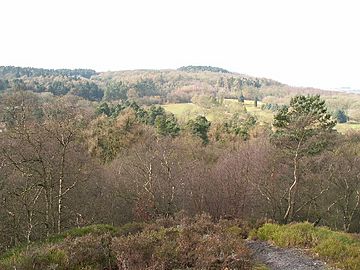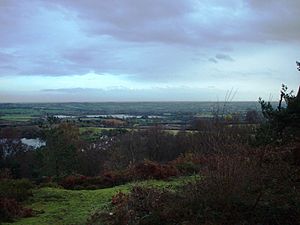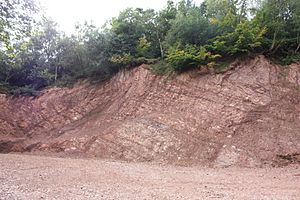Bilberry Hill facts for kids
Quick facts for kids Bilberry Hill |
|
|---|---|

A view from Bilberry Hill over Rosehill Road and the Birmingham Municipal Golf Course towards Beacon Hill. Bilberry bushes can be seen in the foreground.
|
|
| Highest point | |
| Elevation | 243.8 m (800 ft) |
| Prominence | 99 m (325 ft) |
| Listing | Marilyn |
| Geography | |
| Location | Worcestershire, UK |
| Parent range | Lickey Hills |
Bilberry Hill is a cool spot in the Lickey Hills! It's in northern Worcestershire, England. This hill is about 10 miles (16.5 kilometers) southwest of Birmingham. It's also part of the big and beautiful Lickey Hills Country Park.
Bilberry Hill is one of three main hilltops in the Lickeys. The others are Rednal Hill and Cofton Hill. These hills are made of a very hard rock called quartzite. From the top, you can see amazing views of Birmingham and the land around it.
The hill gets its name from the many Bilberry bushes that grow there. These bushes have tasty dark blue berries. For hundreds of years, local people have picked these berries. They use them to make yummy jams, preserves, or pies with apples and bilberries.
History of Bilberry Hill
The Lickey Hills Country Park is a great place to explore today. But it wasn't always open to everyone. In 1888, a group called the Birmingham Society for the Preservation of Open Spaces helped. They bought Rednal Hill and gave it to the city to protect.
Later, in 1913, this group also helped the city lease Bilberry Hill. They also leased Pinfold Wood for a very small, symbolic rent. This meant the land would be open to the public forever.
The city of Birmingham bought Cofton Hill, Lickey Warren, and Pinfield Wood in 1920. Then, in 1923, they bought the Rose Hill Estate from the Cadbury family. This finally opened up all the hills for everyone to enjoy. In 1971, this whole area officially became the Lickey Hills Country Park.
The Bilberry Hill Centre
At the bottom of Bilberry Hill, there's a special place called the Bilberry Hill Centre. It's a hostel and sports facility for young people. Mr. and Mrs. Barrow Cadbury gave this building to the people of Birmingham in 1904. It was first known as the Lickey Tea Rooms. People used it as a restaurant until the early 1960s.
Today, the hostel can host up to 65 people. It's a popular spot for groups and clubs. In 2008, there was a worry that the center might close. But people worked together online to help save it. This ensured it could keep helping young people for years to come.
What Bilberry Hill is Made Of
The Lickey Hills area is very interesting for people who study geology. Geology is the study of Earth's rocks and how they formed. The rocks here are very old and show a lot about Earth's past.
The dark quartzite rock that makes up Bilberry Hill is special. It shows signs that it was once sand at the bottom of a shallow sea. Over millions of years, this sand turned into the hard rock we see today.
The different types of rocks in the Lickey Hills create different landscapes. They also create different habitats for plants and animals. Here are some of the main rock layers you can find:
- Barnt Green rocks: These are old volcanic rocks and mudstones.
- Lickey Quartzite: This is the hard quartzite rock of Bilberry Hill. It has thin layers of mudstone too.
- Halesowen Formation: This is a type of mudstone.
- Clent Formation: This rock is made of broken pieces of older rocks stuck together.
- Bunter Pebble Beds: These are layers of smooth, water-worn pebbles.
The soil on Bilberry Hill is mostly marl, which is a mix of clay and lime. Below that, you'll find gravel, sand, and clay. There's also a small quarry where limestone was once dug out. This limestone was used when the Worcester and Birmingham Canal was being built. You can also find some old gravel pits around the area.



